
STEVEN J. ZALOGA, illustrated by JIM LAURIER
V-1 FLYING BOMB. 1942-52. HITLER'S INFAMOUS "DOODLEBUG"
The Reichenberg piloted missile
The most notorious version of the Fi-103 was the Fi-103R Reichenberg, a piloted version intended for attacks on high-value targets. Hitler's favorite adventurer, Otto Skorzeny, and the famous test pilot, Hanna Reitsch, have both laid claim to the idea. The pilot would steer the missile at the target and, if lucky, would parachute out at the last second. Many Luftwaffe commanders were disturbed by the suicidal nature of the scheme, recognizing that other guided missiles such as the Hs-293 or the Mistel could perform the same role. But in the paranoid atmosphere of the time, it was unwise to challenge the pet projects of Hitlers associates.
Modification of the Fi-103 was fairly simple, and the Henschel plant at Berlin-Schönefeld designed a rudimentary cockpit plus a pair of ailerons to provide better flight control. Flight tests of a prototype began at the Rechlin test center in September 1944. The pilot of the first flight suffered severe spinal injuries due to the high speed of the landing and the use of a rudimentary landing skid without shock absorbers. During the second flight, the canopy blew off and the pilot was seriously injured during the landing. After improvements were made, additional flights were conducted, including several by Willy Fiedler of Fieseler and Hanna Reitsch.
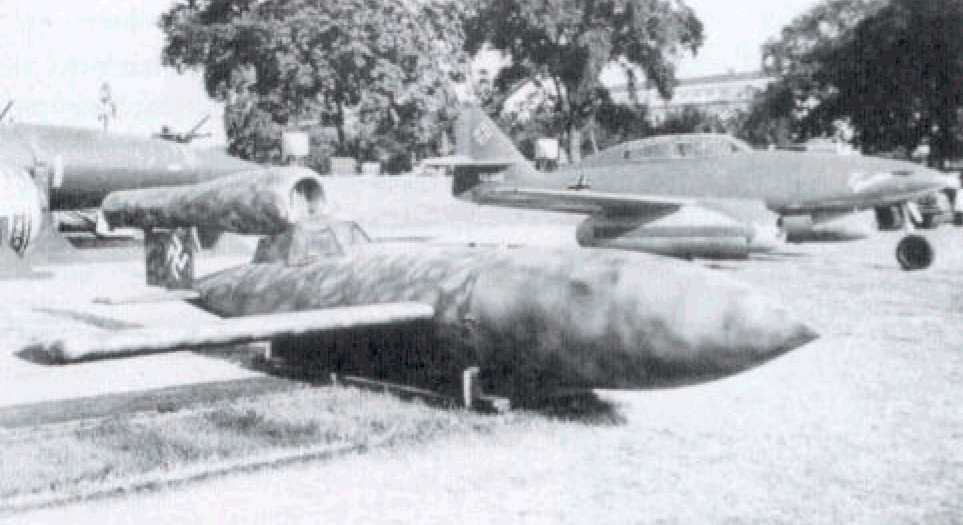
Since most of the Reichenbergs discovered at Dannenberg lacked a warhead, many of the examples sent back to the United States for display ended up with bogus noses. This particular example was part of a display in Washington, DC, immediately after the war and has both a fake nose and a phony swastika marking on the tail. (MHI)
The Fi-103Re.1 proved difficult to fly, and so in September a two-seat, unpowered trainer was built as the Fi-103Re.2 and in November the Fi-103Re.3 powered two-seat trainer was assembled. During the second test (light of the Fi-103 Re.3 on November 5th, 1944, the left wing fell off due to vibrations from the engine, though test pilot Heinz Kensche managed to extract himself from the cramped cockpit. This inadvertently demonstrated the enormous difficulty of parachuting from the Reichenberg, even for a skilled test pilot.
Reichenberg operations were assigned to the "Leonidas Staffer of the special-operations unit, KG200. The Inspector of Bombers, Generalmajor Walter Storp, wanted to create an entire suicide division, dubbed Jägerdivision Hermann Göring. Of the 70 volunteer pilots, about half had received some measure of training by late February 1945, when further training was suspended due to a lack of fuel. Testing of the Reichenberg continued at Rechlin, and on March 5th, 1945, test pilot Kensche's luck ran out when a modified Fi-103Re.3 with shortened wings had both wings peel oil dining a test flight. This was the last straw for the commander of KG200, Oberstleutnant Baumbach, who got into a bitter argument with General Storp over the stupidity of the whole venture. Baumbach asked the head of the German war industry, Albert Speer, for help. On March 15th, Speer and Baumbach visited Hitler and Speer helped convince him that suicide attacks were not part of the tradition of German warriors. Hitler agreed, and later that day, Baumbach ordered the commander of IV/KG200 to disband the unit. Over 200 Reichenberg missiles were converted by Luftwaffe munitions depots at Dannenberg and Pulverhof, but none were ever deployed except for those at the Rechlin test establishment.
Curiously enough, Japanese liaison officers visited the facility on several occasions. German technological assistance formed the basis for the Japanese analog of the Reichenberg, the Kawanishi Baika ("Plum Blossom") kamikaze aircraft which was not finished before the end of the war.
The US Army Air Force in 1944 was very impressed with the V-1 if for no other reason than the enormous amount of resources used to combat it. Nearly a ton of V-1 parts were rushed to Wright-Patterson Field on July 12th, 1944, and the staff was ordered to build 13 copies called the JB-2 (Jet Bomb 2). Amazingly, these were completed in three weeks, and a recommendation was made to begin quantity production. The War Department was not very keen on the idea, pointing out that its lack of accuracy limited its use to terror bombing. But production was finally authorized with an understanding that its guidance would be improved. In late July 1944, the USAAF ordered 1,000 JB-2 missiles with Republic and Willys building the airframe, and Ford the engine. Northrop designed a new ramp with rocket sled since details of the German launcher were not available. The USAAF planned to order 1,000 per month, increasing to 5,000 per month by September 1944. General Spaatz (commanding US strategic bomber forces in Europe) was not keen on deploying the JB-2 in Europe, feeling that it would adversely impact the supply of more conventional ordnance and that it was not accurate enough to be worth the trouble. After the initial burst of enthusiasm, a more sober appreciation of the limitations and high cost of the program sank in, and in late January 1945 the War Department stopped any further production contracts for the JB-2. When production ended in September 1945, 1,391 JB-2s had been built.
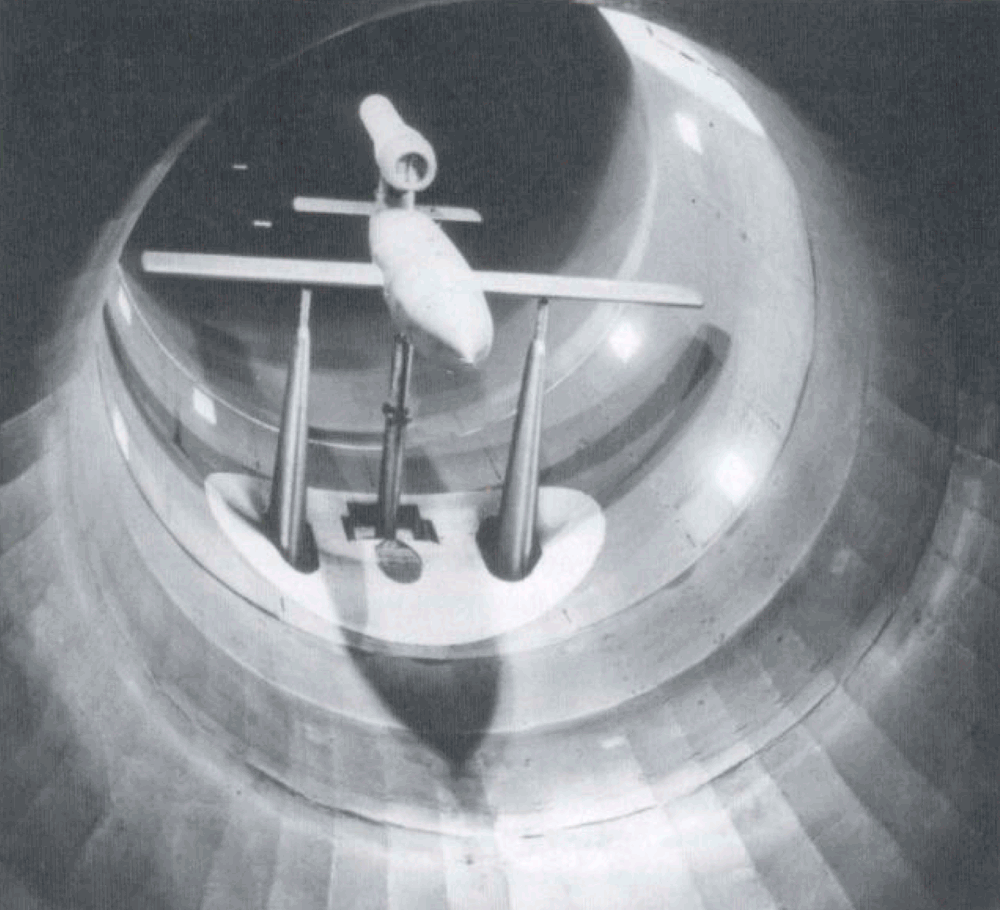
The US Army Air Force was quick to exploit captured V-1 technology and manufactured a copy, the JB-2, in late 1944. This shows a test example in a wind tunnel. (NARA)
The first JB-2 Thunderbug was launched at Eglin Air Force Base in October 1944. The USAAF had many of the same problems its the Germans and, by early December 1944, only two often test launches had been successful. By June 1945 the record had improved to 128 out of 164 test launches. The USAAF tested several launch methods including a 400ft inclined ramp, a level ramp with rocket sled, and 50ft trailer ramps. Air launches were also attempted, flying two JB-2 Thunderbugs under the wings of a B-17G bomber. The USAAF also tested improved guidance, using radar tracking to provide data for radio commands to update the inertial autopilot. After expending the remaining missiles during tests in 1949, the air force abandoned the JB-2 due to its poor accuracy and the limitations of its pulse-jet engine. None were used in combat.

The US Navy was not keen on long launch ramps, and eventually developed a zero-length launcher using rocket-assisted take-off, as seen here with Loon No. 244 aboard the test ship USS Norton Sound in August 1949. (NARA)
Not to be cut off from this new technology, in 1945 the US Navy asked the USAAF to set aside 351 missiles which it called the LTV-N-2 Loon (Launch Test Vehicle-Naval). Under Project Derby, these were initially launched from shore-based ramps and surface ships. The Navy had many problems with these, managing only five successful launches out of its first 84 from January 1946 to December 1947. The Navy shifted the emphasis of the program in 1946 to study the use of cruise missiles from submarines, and conducted the first launch of a cruise missile from a surfaced submarine on February 12th, 1947. The Navy wanted a less cumbersome launcher, and developed a zero-launch ramp using an improved rocket booster that was first tested from the USS Norton Sound on January 26th, 1949. During the last series of trials from January 1948 to March 1949, 37 of 70 launches were successful. However, the Navy was never very happy with the Loon, and began working on a jet-powered cruise missile, the Regulus, in November 1947. Some thought was given to firing a few Loons at North Korea during the 1950-53 war, but there was no compelling reason to do so. Curiously enough, a Hollywood movie. The Flying Missiles (starring Glenn Ford), was made based on the missile submarines.

The US Navy Loon program was intended to examine the suitability of future cruise missiles for submarine launch. Here, Loon No. 995 is launched from SSG-337 USS Carbonera off the California coast on December 2nd, 1950.
News of the German missile attacks on London prompted Stalin on June 13th, 1944, to order the start of a program to develop a Soviet counterpart. Vladimir Chelomey had been working on pulse-jet engines, so was assigned the task in October 1944 and given control of the OKB-51 design bureau after the famous fighter designer N.N. Polikarpov died. The Red Army collected a partial V-1 at the Blizna test range in Poland. The initial V-1 copy was called the 10Kh and later Izdeliye 10 ("Article 10"). The Russian Cyrillic letter "Kh" resembles the Roman "X" so these early missiles were nicknamed the "Iksy" or "Xs" for this reason. Serial production was scheduled to begin in March 1945 starting at 100 per month and building up to 450 monthly by later in the year.
Since no launch ramps were ready, the first launch was conducted from a Pe-8 bomber on March 20th, 1945, in central Asia near Tashkent.
By late August, 63 missiles had been launched, of which about a third reached the target area, A batch of 180 improved 10Kh (Izdeliye 30) missiles with wooden wings was built, and 73 more air launches were conducted in December 1948. A ground-launched version called the 10KhN was also tested in 1948 using rocket-assisted take-off and a ramp. In all the program dragged on for more than five years as improvements were made to the guidance, propulsion and launch system but the last series of tests in 1951 was disappointing.
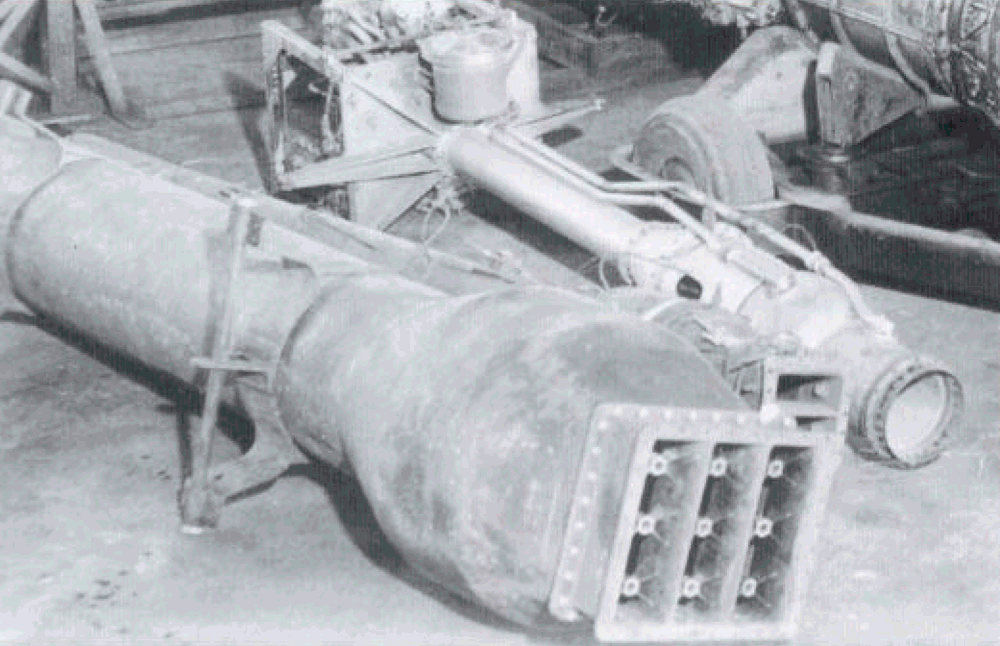
The Germans provided the Japanese with considerable information on the V-1 and its Argus pulse-jet engine. The only tangible outcome of this cooperation was the construction of prototypes of the Maru Ka-10 pulse-jet engine for the still-born Kawanishi Baika kamikaze. One is seen here in the foreground along with a Toko Ro.2 rocket motor copied from the Walter HWK 509A of the Me-163 Komet fighter. (NARA)
In parallel to the improved 10Kh with its D-3 pulse-jet, ten improved 14Kh with the more powerful D-5 engine were built in 1947. These had a tapered wooden wing with ailerons, but otherwise resembled the 10Kh. Test launches were conducted from Pe-8 bombers in July 1947.
By this time it was becoming clear that both the 10Kh and 14Kh were a technological dead-end due to the inaccuracy of their guidance system. A new radar beam-riding system was in development at the time, codenamed Kometa, and this was fitted to the new 16Kh Priboy ("Surf') missile, which also introduced paired D-14-4 pulse-jet engines. Test launches of the 16Kh were initially conducted from a Tu-2 bomber and 17 launches were made in January-June 1948. Improvements were made to the Priboy, and work on a TV-guided version also started. Following 1951 tests from the Tu-4 bomber, the state commission recommended putting the missile into production, but the Soviet Air Force was unhappy with its poor accuracy, unreliability, and cold weather performance. In parallel to the 16Kh, the Mikoyan fighter bureau was developing a jet-powered cruise missile, the KS-1, that offered a more satisfactory performance. KS-1 production began in late 1952, and the first series production missiles were turned over to a Tu-4K bomber regiment of the Black Sea Fleet in May 1953. This missile was later called the AS-1 Kennel by NATO. As a result, the 10KhN land-launched missile and 16Kh air-launched missile programs were terminated on February 19th, 1953, in favor of the Mikoyan missile, though there were some efforts to revive them its test drones in the mid-1950s. In spite of the failure of the program, Chelomey later went on to head NPO Mashinostroyenie which became one of the most successful Soviet missile design bureaus, developing numerous cruise missiles, ballistic missiles, space boosters, and satellites.
Besides the Chelomey missile program, in October 1945 the Soviet- controlled Junkers plant at Dessau in Soviet-occupied Germany was assigned to develop a piloted attack fighter version of the V-1, called the EF-126. A total of five pilots were completed in 1946, and glide tests began in May 1946. The definitive production version would be armed with a pair of 20mm cannon and a new Jumo 226 jet engine. The second test flight on May 21st, 1946 resulted in a crash which killed the German lest pilot. The remaining prototypes along with pilot versions of the Jumo 226 engine were sent to the Soviet Union, but the program was soon abandoned.

The Soviet EF-126 attack aircraft. (Author)
Of the major powers, Britain never manufactured a copy of the V-1, though the Red Rapier cruise missile program of 1950 was certainly inspired by it. Therefore the only other air force to copy the V-1 in any significant numbers was the French. Arsenal de l'Aéronautique in Châtillon began work on a V-1 copy in 1947, It was not intended as a cruise missile, but rather as a jet-powered target drone for use with new air-to-air missiles that the firm was designing. Designated as CT 10, the first trials of the drone were completed in April 1949. It was actually smaller than the V-1, and used twin rudders like the original German Erfurt proposal. CT 10 could be launched from a ground ramp using solid rocket-assisted take-off, or from aircraft such as the Leo 451 medium bomber. About 400 were manufactured and some were sold to Britain and the United States.
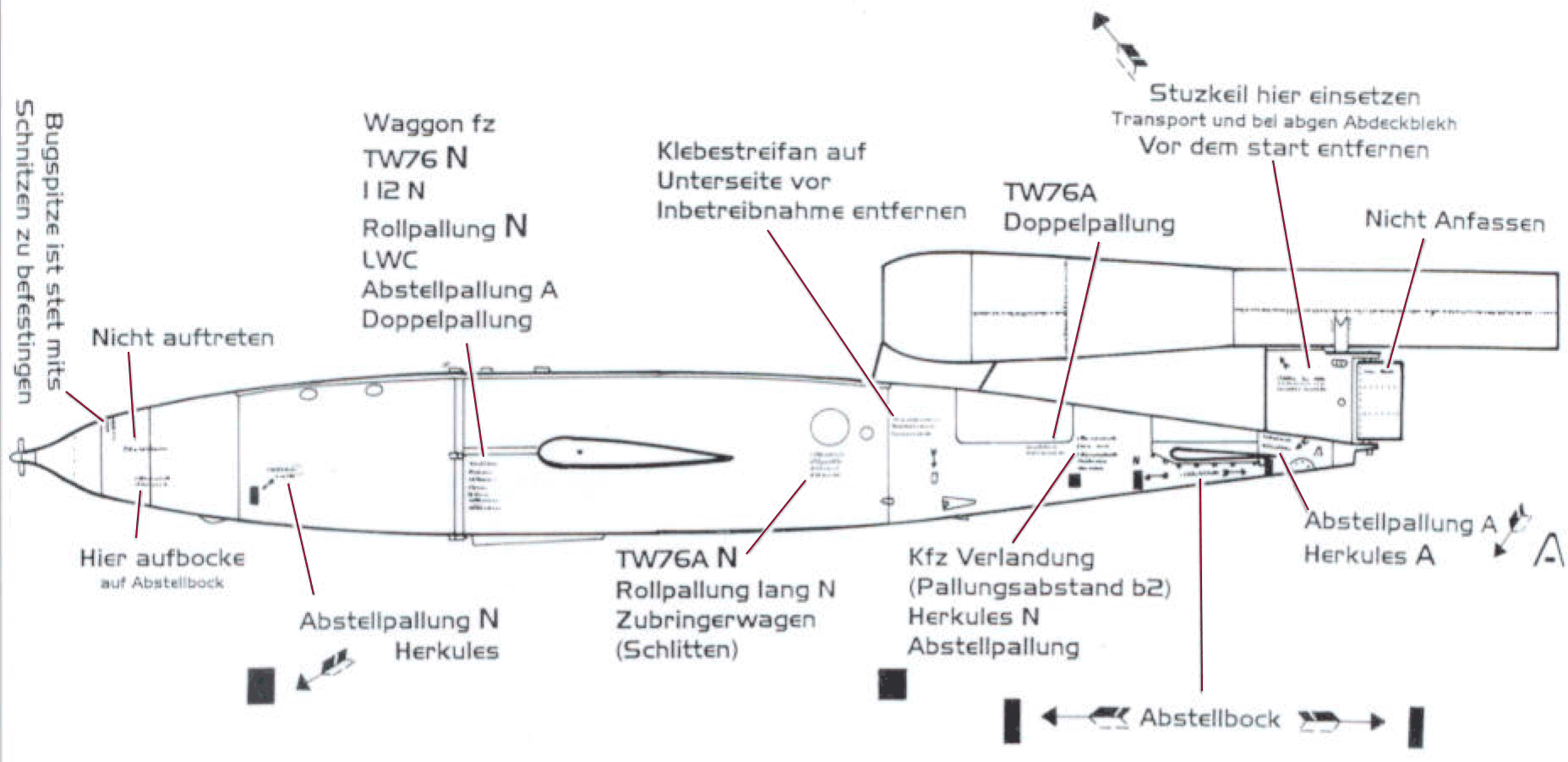
This illustration shows the typical stenciling on the V-1. Usually, the stencils were in white on the green upper surfaces and black on the light blue undersurfaces. (Author)

A1: FI-103 V-ZELLEN, PEENEMÜNDE, SPRING 1943
Test missiles were often painted in bright colors to assist in visual tracking. Originally, they were painted in overall yellow, but this switched to bisected yellow and black which made it easier to see if a missile flipped on to its back. The Argus engine was left in its original unpainted steel finish. The serial number was painted on the tail, in this case, 91 for V91.
A2: FI-103 M-ZELLEN, LEHR-UND-ERPROBUNGSKOMMANDO WACHTEL, PEENEMÜNDE, FALL 1943
The pre-series M-zellen missiles were finished in a relatively neat scheme of RLM 71 (The Reichsluftministerium - German Air Ministry - had an official series of numbered designations for paint colors, prefixed "RLM") dark green over RLM 65 light blue. The serial number was applied to the tail in white.
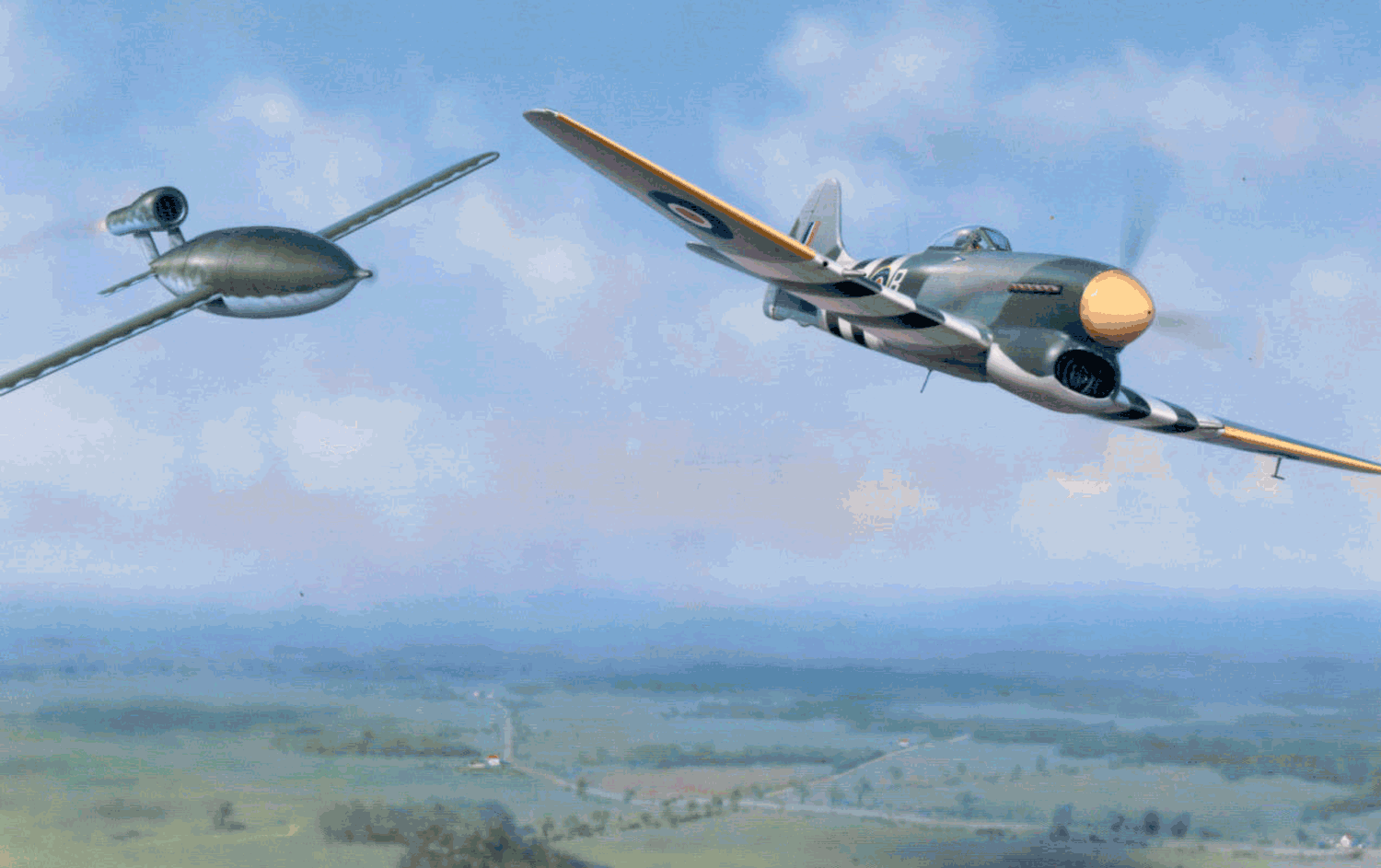
A3: FI-103RE.3 REICHENBERG TRAINER, RECHLIN TEST ESTABLISHMENT, FEBRUARY 1945
The few photos that exist of these trainers show them to be in a fairly neat finish. On August 15th, 1944, the RLM ordered the withdrawal of RLM 65, substituting three new greens after existing paint was exhausted at the factories. Bombers retained the RLM 65 light blue, which also affected Fi-103. The results were not that noticeable on the V-1 as most surviving examples seem to show the use of RLM 71 dark green or the similar RLM 83.
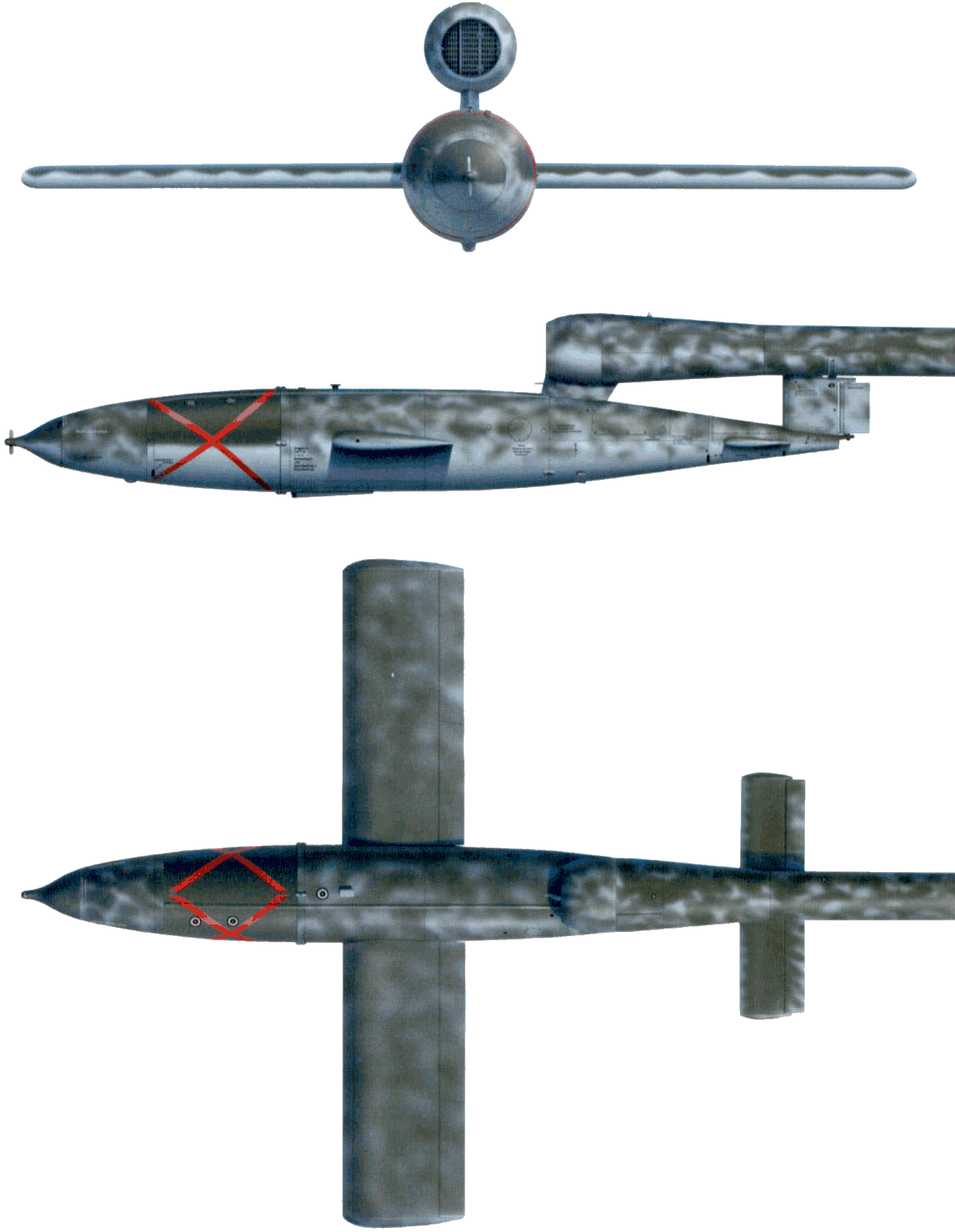
B: DIVER DOWN! LONDON, AUGUST 1944
This scene depicts one of the duels between the Doodlebugs and RAF Tempests. In some circumstances, such as when they had run out of ammunition, fighter pilots would position one of their wingtips under the Doodlebug wing, and then bank sharply, the slipstream causing the V-1 to tumble out of control as is seen here.
C: FI-103A-1, FLAK REGIMENT 155 (W), SUMMER 1944
Many of the FZG-76 missiles used in the summer of 1944 had a very motley finish as little care was taken in applying paint on a cheap, expendable weapon. In addition, the missile was assembled from components coming from different plants, so the camouflage schemes on the all the parts did not match. The base color was the usual RLM 65 light blue over which RLM 71 dark green was sprayed in irregular patterns. The wing and tail surfaces as well as the spine of the engine tended to have a more solid finish of dark green. Missiles with Trialen enhanced blast warheads sometimes had a large red X painted on either side of the warhead casing as seen here.
D: FI-103A-1, FLAK-REGIMENT 155 (W), 1944

1 Air pilot propeller
2 Magnetic guidance compass
3 Belly impact fuze
4 Main warhead exploder tube
5 Warhead explosive filling
6 Reinforcement support for launch rail
7 Main wing spar
8 Stamped metal wing reinforcing rib
9 Forward compressed air bottle
10 Rear compressed air bottle
11 Fuel flow control
12 Electrical battery
13 Flight control
14 Askania gyro flight control box
15 FuG-23 radio transmitter
16 Control surface servos
17 Trailing FuG-23 radio antenna
18 Rudder
19 Rear pulse-jet engine yoke
20 Argun As 109-014 pulse-jet engine
21 Engine ignition spark plug
22 Venturi assembly
23 Engine shutter assembly
24 Forward engine support yoke
25 Pilot tube
26 Fuel tank
27 Center lifting lug
28 Fuel filler cap
29 Rear Z80A fuze pocket
30 Forward Z80A fuze pocket
SPECIFICATION
Fuselage length: 21ft 10in. (6.65m)
Overall length: 25ft 4in. (7.73m)
Fuselage diameter: 2ft 8in. (0.825m)
Wingspan: 17ft 6in. (5.33m)
Launch weight: 4.858lbs (2.200kg)
Fuel: 160 US gal (610 liters; 134 Imp gal) E-1 aviation gasoline
Warhead: 1.870lbs (850kg) Amatol high explosive, redundant impact fuzes
Guidance: Askania pre-set autopilot with gyro inertial platform and magnetic compass
Engine: Argus 109-014 pulse-jet, max. thrust 310kg at 1,000m at 700km/hr
Max. cruise speed: 415mph at 4.500ft (670km/hr at 1,375m)
Maximum range: 125-130 miles (200-210km)
Rate of fire: 72 per launcher per day maximum: about 3 per day actual rate in 1944
Accuracy (ground-launched): Circular error probability of 8 miles (13km)

E: FI-103RE.4 REICHENBERG, KARLWITZ MUNITIONS DEPOT, DANNENBERG, GERMANY, 1945
As in the case of the Reichenberg trainer shown in Plate A. the Reichenberg trainers theoretically were painted in late-war RLM colors of RLM 65 light blue and RLM 83 dark green. This shows the standard configuration of the missile had it been deployed in the spring of 1945.
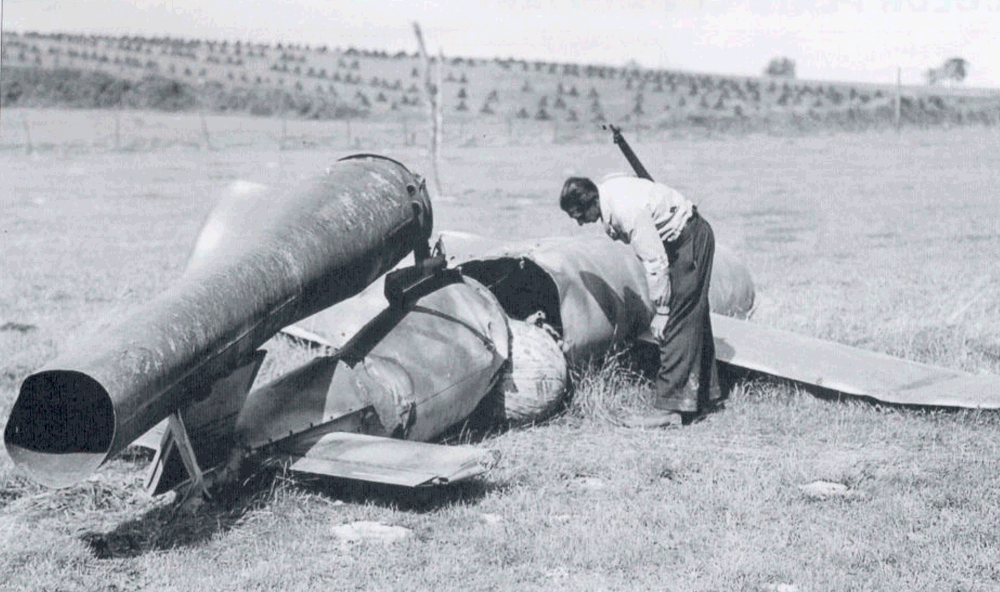
This V-1 was one of many that prematurely crashed after launch in the French countryside, and is being examined by a member of the French resistance. The fuselage has split open behind the center fuel tank, exposing one of its two pressurized air bottles. (NARA)
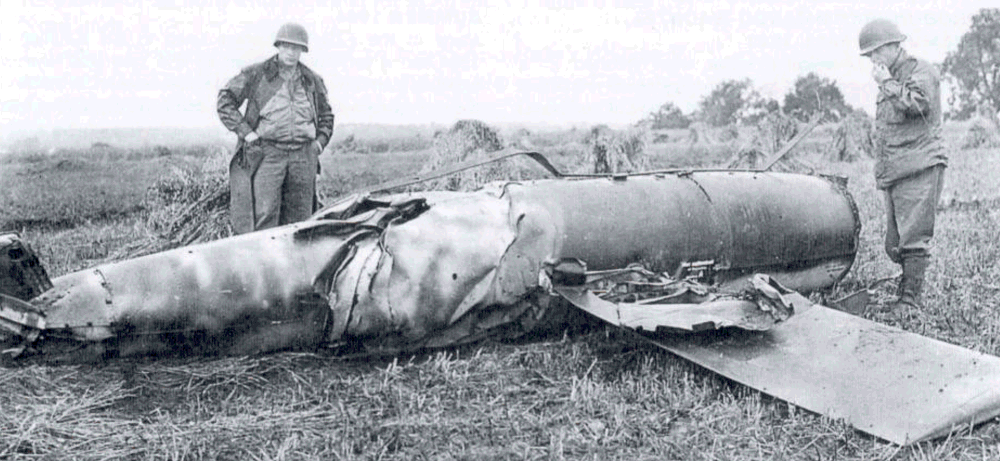
This V-1 was found by US troops near Plomion, France, on September 2nd, 1944, in the sector where I/FR155W was formerly based. The Germans codenamed these crashed missiles as Kieselsteine ("Gravelstones") and special teams were sent to deal with the unexploded warhead which is missing on this example. (NARA)
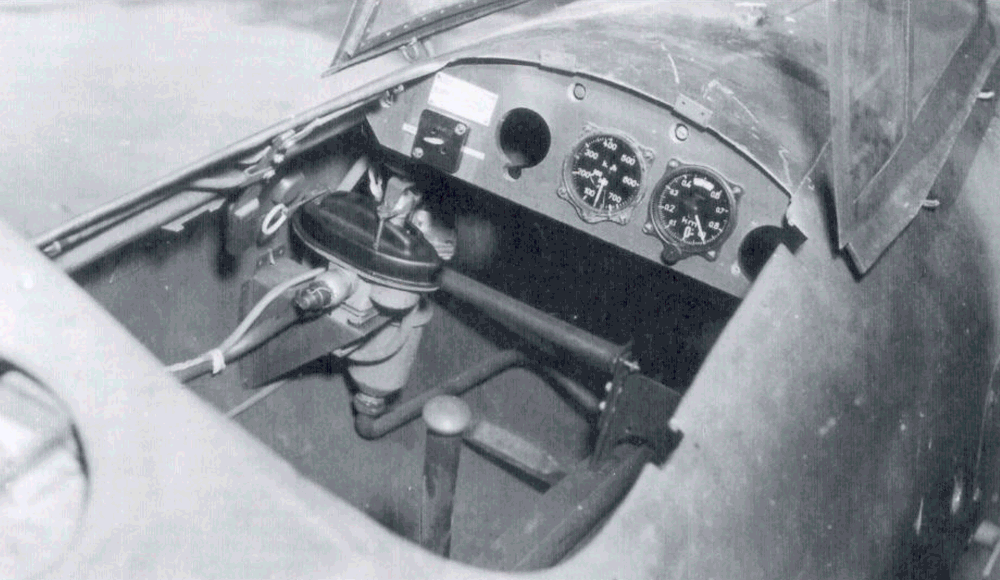
A view into the cockpit of one of the Fi-103Re.4 Reichenbergs discovered at Dannenberg shows the very elementary controls and instruments. (NARA)
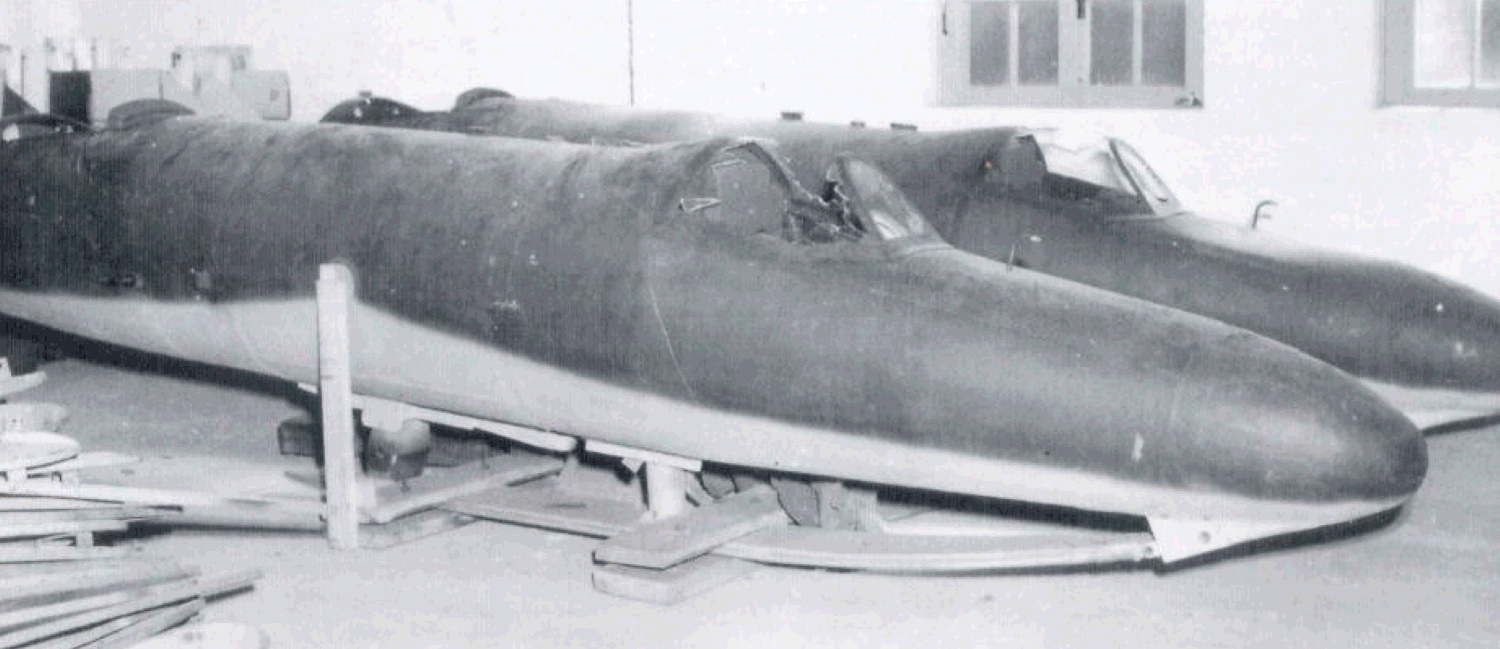
Another discovery at Dannenberg was a small number of incomplete Fi-103Re.3 two-seat trainers. (NARA)
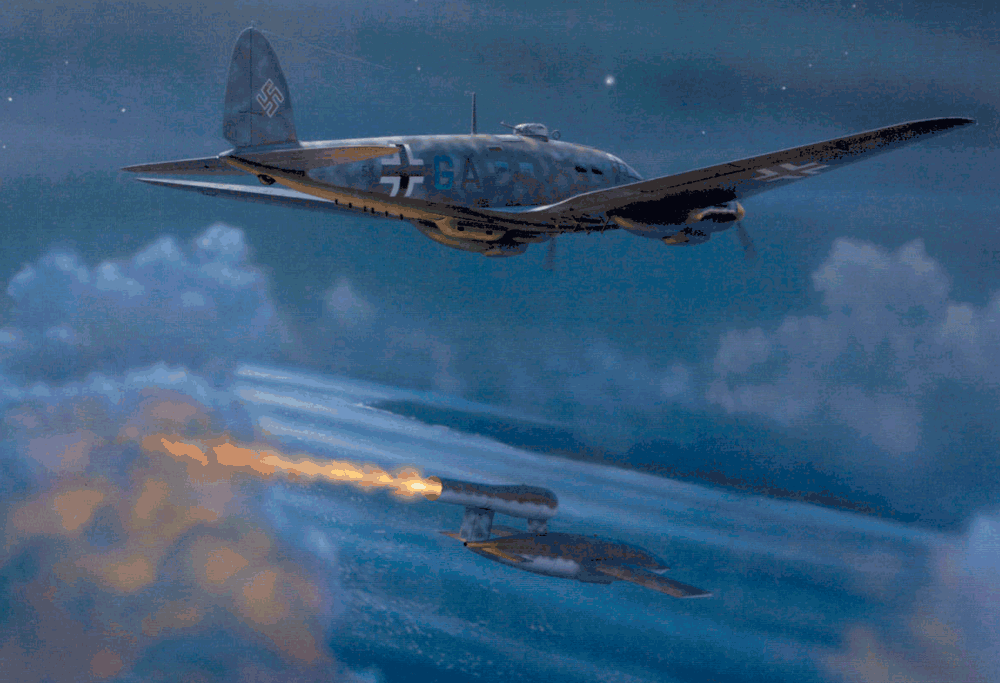
F: HELLHOUNDS OVER THE NORTH SEA, OCTOBER 1944
This scene depicts a night launch of an Fi-103A-1 over the North Sea by an He-111H-22 of KG3. The missiles were usually released from an altitude of at least 1,500 ft as they tended to drop a few hundred feet after launch until the engine accelerated the missile to cruise speed. The Heinkel is quickly banking away, since the launches were visible for long distances and would attract the unwanted attention of Mosquito night fighters.

G: 16KH PRIBOY, SOVIET AIR FORCE, 1951
Although the Soviet Air Force was shifting to the use of bare aluminum finishes on its jet aircraft in 1950, air-to-surface missiles such as the Priboy sometimes remained in the standard late 1940s camouflage finish of overall AMT-11 gray-blue. However, since this was a test missile, the engine remains in a bare steel finish.
We have much more interesting information on this site.
Click MENU to check it out!
∎ cartalana.com© 2009-2025 ∎ mailto: cartalana@cartalana.com